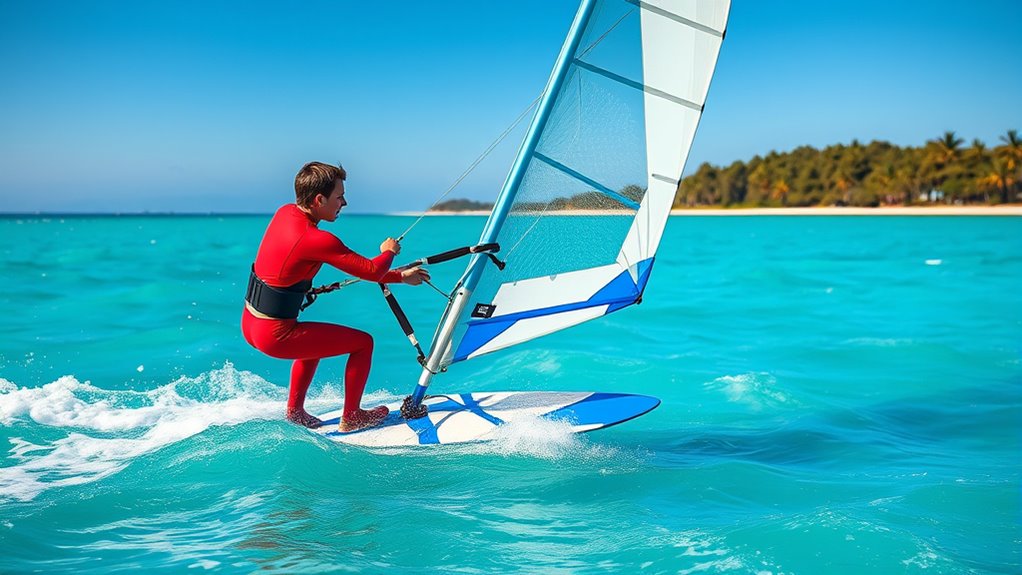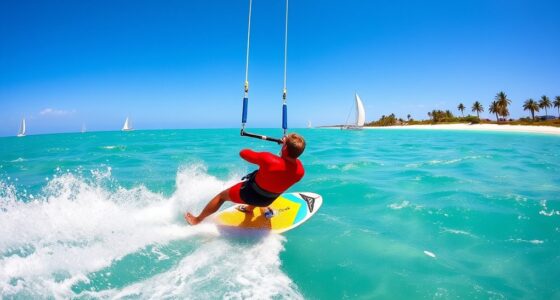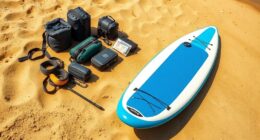To start windsurfing as a beginner, focus on choosing stable, well-maintained equipment suited for your skill level, including a larger board and comfortable gear. Practice developing a balanced stance with feet shoulder-width apart, keeping your weight centered and knees slightly bent. Learn to read wind conditions using visual cues like flags and water ripples, and practice smooth sail handling during launches and landings. Keep safety gear on and stay calm—continue exploring these fundamental techniques to build confidence on the water.
Key Takeaways
- Choose stable, well-maintained equipment suited for beginners to build confidence and ensure safety.
- Maintain a proper balanced stance with feet shoulder-width apart and keep hips centered over the board.
- Read wind patterns and adjust the sail accordingly to optimize control and prevent overpowering.
- Practice launching and landing techniques, facing into the wind and steering smoothly for safety.
- Prioritize safety gear, environment awareness, and mental focus to develop skills confidently and avoid hazards.
Choosing the Right Equipment

Have you ever wondered how the right equipment can make or break your windsurfing experience? Choosing the right gear is essential. Start with your board size; a beginner should opt for a larger, more stable board. Make sure your equipment is well-maintained; regular equipment maintenance ensures safety and performance. Pay close attention to your windsurfing apparel, selecting wetsuits and harnesses that fit comfortably and keep you warm. Properly fitting gear prevents discomfort and improves control. Don’t forget to check the condition of your sails and fins before hitting the water. Investing in quality equipment tailored to your skill level helps you build confidence and progress faster. Remember, the right equipment isn’t just about performance—it’s about enjoying windsurfing safely and comfortably. Proper equipment care also plays a crucial role in extending the lifespan of your gear and maintaining optimal performance. Additionally, understanding the benefits of high refresh rates can help you choose projectors that deliver smoother visuals, which is especially important for immersive experiences. To optimize your windsurfing experience, consider how GMC tuning techniques can be analogous to fine-tuning your gear for better control and performance on the water. Regularly inspecting and maintaining your gear, similar to filtration and pump protection, ensures consistent and reliable performance during your sessions.
Mastering Basic Stance and Balance
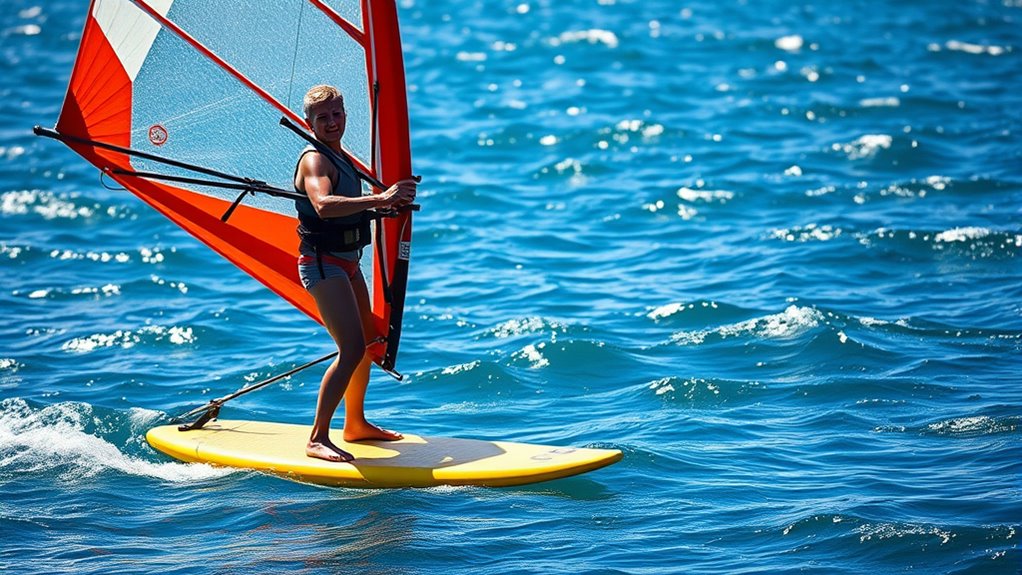
To stay steady on your board, focus on placing your feet properly and keeping your weight centered. Engage your core muscles to maintain balance, especially as the wind picks up. With these basics, you’ll build a solid foundation for confident windsurfing. Incorporating proper exfoliation techniques can also help keep your skin healthy and prepared for sun exposure during water activities.
Proper Foot Placement
Your foot placement is crucial for maintaining balance and control while windsurfing. Proper foot placement helps you stay stable and respond quickly to changing conditions. Position your feet shoulder-width apart, with your stance aligned to the board’s width. Keep your front foot pointing straight ahead or slightly inward, while your back foot can be angled slightly outward for better control. Focus on maintaining a balanced stance alignment, with your weight distributed evenly on both feet. This stance allows you to shift your weight smoothly and react to gusts of wind or waves. Avoid placing your feet too close together or too far apart, as either can compromise your stability. Mastering proper foot placement is essential for building confidence and progressing in windsurfing. Additionally, understanding the importance of stance stability can help you refine your technique and stay balanced in various conditions. Ensuring proper foot positioning also enhances your ability to respond effectively to sudden changes in wind or water movement. Developing consistent balance and posture is key to improving your overall windsurfing skills. Proper equipment adjustment can further optimize your stance and control.
Maintaining Center of Gravity
How can you stay balanced on a windsurfing board? The key is maintaining your center of gravity directly over the board’s center. Keep your weight evenly distributed between your front and back foot, which helps stabilize your stance. Shift your weight gradually to adjust your balance as the wind and water conditions change. Focus on keeping your hips centered over the board, not leaning too far forward or backward. This ideal weight distribution allows you to react quickly to shifts and maintain control. Remember, a lower center of gravity improves stability, so bend your knees slightly and stay relaxed. Consistently monitoring and adjusting your stance ensures you stay balanced, making your windsurfing experience safer and more enjoyable.
Engaging Core Muscles
Engaging your core muscles is essential for mastering a stable windsurfing stance. When you activate your core, you improve core stability, which helps you maintain balance and control. Proper muscle engagement keeps you centered over the board, making it easier to respond to changing conditions. Focus on tightening your abdominal and back muscles as you stand. This creates a solid foundation for your movements. Incorporating proper posture techniques for maintaining proper posture can further enhance your stability. Developing muscle coordination through targeted exercises can also improve your overall windsurfing performance. Additionally, understanding spiritual practices such as meditation can help improve mental focus and concentration during your training sessions.
Understanding Wind Direction and Strength
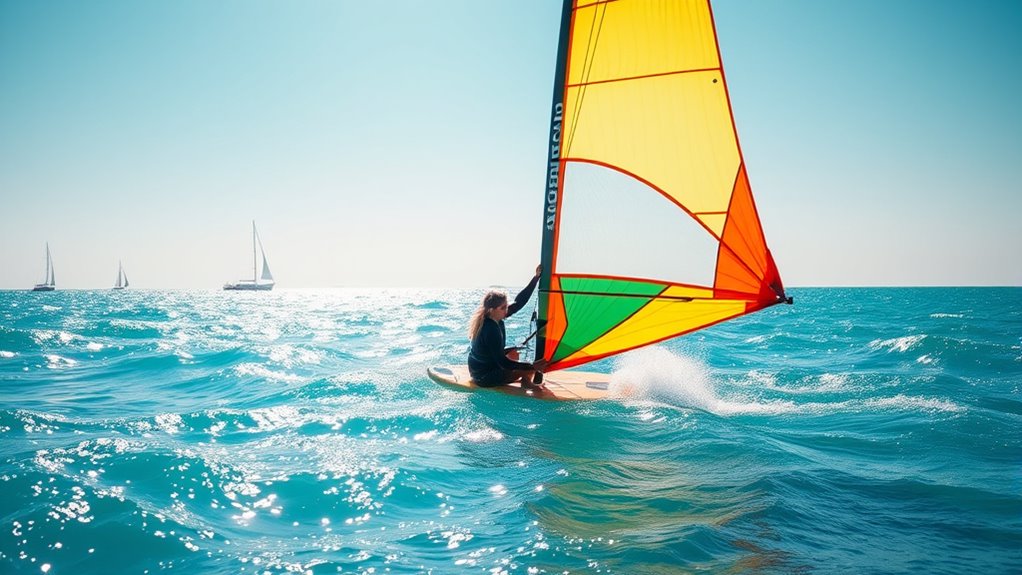
To windsurf effectively, you need to understand how to read wind patterns and judge their strength. You’ll learn how to assess wind speed and determine its direction relative to your position. Adjusting your sail properly depends on this knowledge, helping you stay balanced and control your board. Additionally, recognizing how wind direction and strength influence your sailing experience is crucial for safety and performance. Being aware of celery juice powder and its health benefits can also support your overall wellness and energy levels during active pursuits like windsurfing. Monitoring local weather forecasts can further help you plan your sessions and avoid unexpected weather changes. Understanding the refrigeration cycle can also be useful if you need to keep your equipment in optimal condition, especially during extended days outdoors. Developing a sense of cultural intelligence about different weather patterns and local conditions can enhance your adaptability and safety while windsurfing in new locations.
Reading Wind Patterns
Ever wondered how to tell which way the wind is blowing and how strong it is? Reading wind patterns involves observing subtle cues and understanding weather pattern analysis. Pay attention to how flags, trees, or water surfaces move, as these indicators reveal wind direction. To predict wind pattern changes, study local weather reports and recognize signs like cloud formations or temperature shifts that influence wind strength. Additionally, understanding the impact of Suprem fabric properties can help you select appropriate gear that responds well to varying wind conditions, enhancing your control and safety. Recognizing weather pattern analysis techniques can further improve your ability to anticipate changes in wind behavior. Developing an understanding of wind shear and turbulence can also be beneficial, as these factors can significantly affect wind consistency. This skill helps you anticipate wind behavior during your windsurfing sessions, giving you better control and safety. By practicing wind pattern prediction, you’ll develop an intuitive sense of wind flow, making your time on the water more enjoyable and confident. Mastering these observations ensures you’re better prepared for varying conditions, leading to smoother rides.
Assessing Wind Speed
Once you’ve learned to observe wind patterns, evaluating the wind’s strength becomes the next key step. To do this effectively, you need to measure wind speed accurately. Use simple wind speed devices like an anemometer or handheld wind meter, which provide quick readings and help you gauge if conditions are suitable for your skill level. You can also rely on visual cues, such as the movement of trees, flags, or water ripples, but measuring wind speed offers more precision. Consistently checking wind strength ensures you stay within safe limits and optimize your windsurfing experience. Remember, stronger winds demand different techniques, so knowing how to measure wind speed helps you adapt your approach and ride confidently.
Adjusting Sail Position
Understanding how to adjust your sail based on wind direction and strength is vital for maintaining control and maximizing your speed. Proper sail trim and sail angle help you respond to changing conditions. To optimize your sail position:
- Keep the sail flat when the wind is strong to prevent overpowering.
- Ease the sail out slightly for lighter winds to catch more wind.
- Tilt the sail forward or back to adjust sail angle, depending on whether you’re heading upwind or downwind.
- Constantly monitor your balance and make small adjustments to maintain optimal sail trim.
- Being aware of tuning techniques can help you fine-tune your sail setup for different wind conditions.
How to Properly Launch and Land Your Board
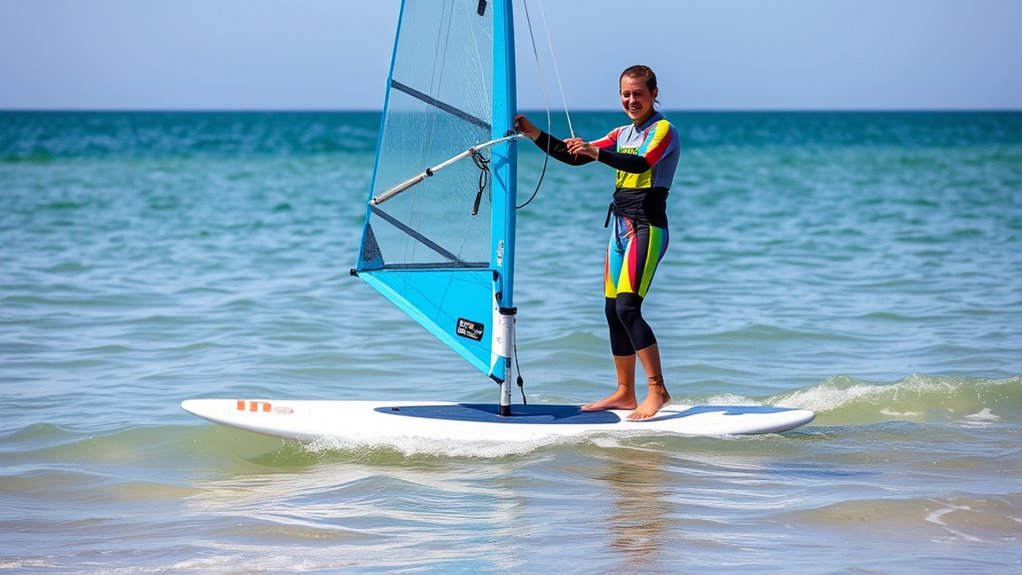
Launching and landing your windsurf board smoothly is essential for a confident start and safe return to the water. Before launching, check your board’s condition—ensure the fins are secure, and the surface is clean to prevent accidents. Consider weather conditions; calm winds and gentle waves make launching easier, while strong gusts can be risky. When launching, position your board facing into the wind, hold the boom, and push off gently from the shore. To land, steer your board toward the beach at a gentle angle, reducing speed as you approach. Keep your body centered and ready to step off or lift the board safely. Proper board maintenance and awareness of weather help guarantee a smooth, safe launch and landing every time.
Holding and Moving the Sail
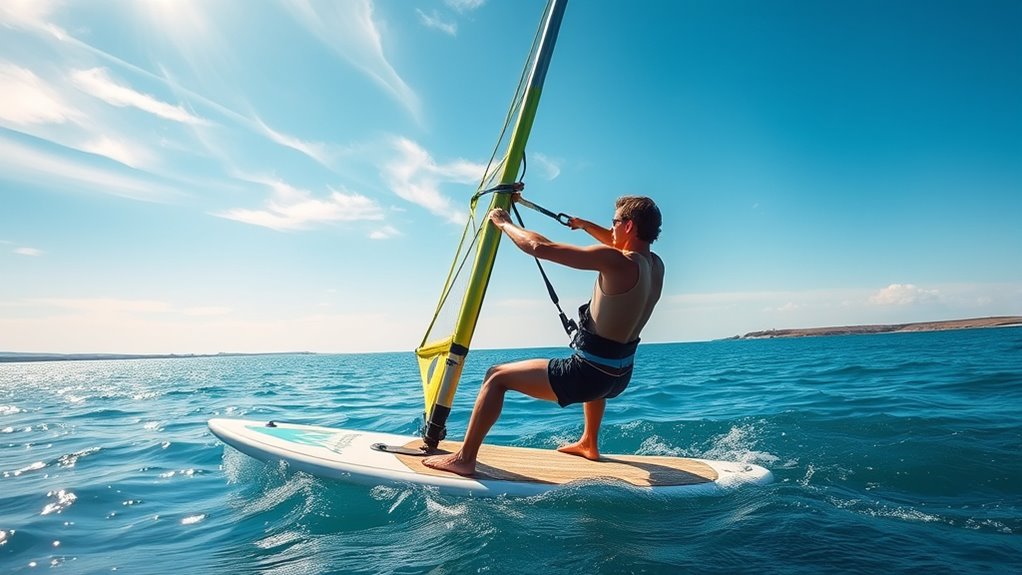
To control your sail effectively, you need to focus on your grip and hand position, keeping your hands comfortably spaced. Steering the sail involves subtle movements, so you’ll want to learn how to turn it smoothly with your arms and body. Adjusting the sail’s tilt helps optimize your speed and balance, so practice finding the right angle for different wind conditions.
Grip and Hand Position
Your grip and hand position are essential for controlling the sail smoothly and maintaining balance on your windsurfing board. A proper hand grip allows you to respond quickly to changing wind conditions. Focus on your finger placement to guarantee a secure hold without over-tightening. Here are key tips:
- Keep your hands shoulder-width apart for stability.
- Wrap your fingers around the boom, with your palms pressing lightly.
- Position your fingers to easily adjust the sail’s angle.
- Maintain a relaxed grip to avoid fatigue and improve feel.
Steering the Sail
Holding and moving the sail effectively allows you to steer your windsurfing board. Good sail control is essential for smooth, responsive steering. Use your arms to gently adjust the sail’s position, keeping it steady and aligned with the wind. To turn, shift your grip slightly, applying more pressure with your back hand and easing with your front hand. This gives you steering finesse, allowing precise direction changes without jerking the board. Keep your body balanced and your stance firm but relaxed, so you can make subtle sail movements. Remember, small adjustments make a big difference in control. With practice, you’ll develop the feel for how slight sail movements influence your board’s direction, making steering more intuitive and confident.
Adjusting Sail Tilt
Adjusting the sail’s tilt is essential for controlling your speed and stability on the water. Proper sail tilt reduces wind resistance and helps you stay balanced. To adjust effectively:
- Grip the boom firmly and keep your elbows slightly bent.
- Tilt the sail forward or backward to find the most favorable angle against the wind.
- Move the sail smoothly to maintain steady wind resistance.
- Watch how the sail responds; a slight tilt can greatly influence your movement and stability.
Steering and Turning Techniques
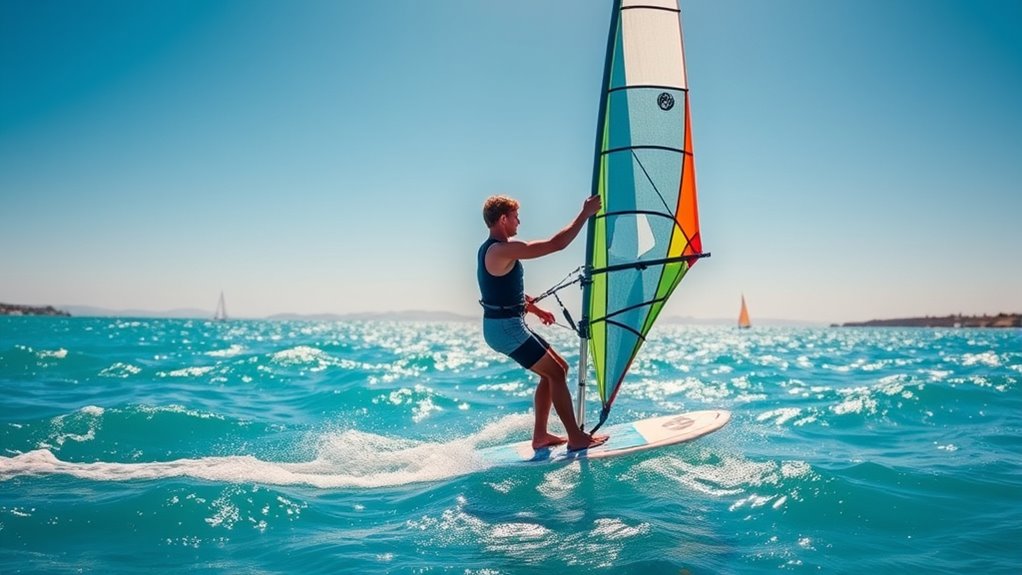
Mastering steering and turning is essential for gaining control and confidence on the water. To turn smoothly, adjust your sail trim to optimize wind navigation. Lean into the turn by shifting your weight slightly to the leeward side, while steering the board with your back foot. Use your arms to steer the boom, guiding the board’s direction.
| Technique | Description |
|---|---|
| Carving Turns | Shift weight and edge the board into the turn. |
| Jibe Technique | Turn downwind, switch stance, and maintain speed. |
Focus on small, controlled movements rather than abrupt ones. Practice shifting your weight and adjusting sail trim to feel how your board responds. With consistent practice, steering and turning become intuitive, giving you more confidence on every sail.
Upgrading Your Skills to Water Start
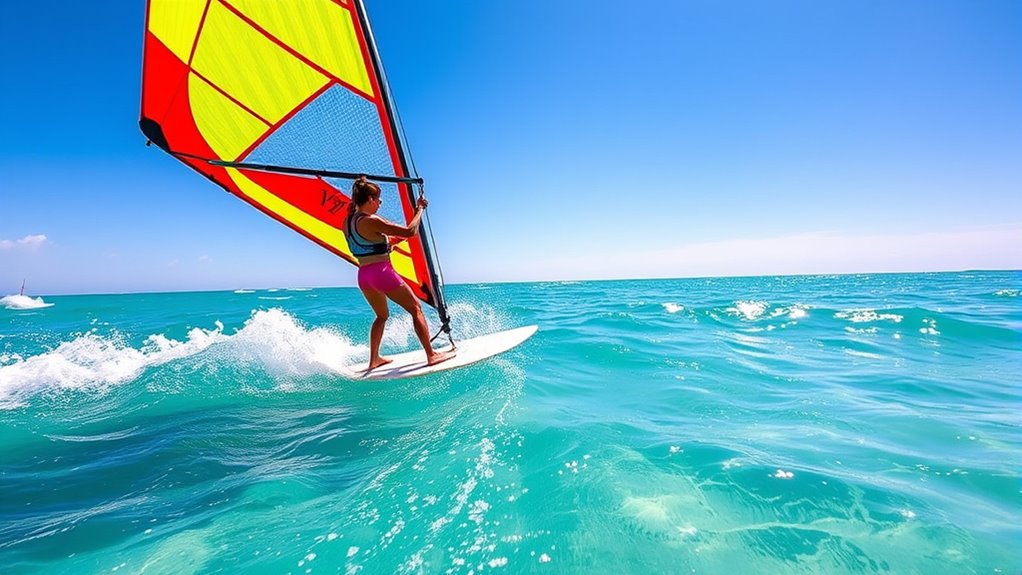
Learning to water start is a crucial step that allows you to get on your board from a floating position without the need to drift into shallows or rely on a launch. To master this, focus on refining your balance techniques through specific water start drills. These drills help you develop the stability needed to lift the sail and pop up smoothly.
Here are key steps to upgrade your skills:
- Practice paddle and sit balance on your board to build core stability.
- Use water start drills to simulate the movement, focusing on maintaining even weight distribution.
- Work on timing your sail lift and pop-up with your balance shift.
- Keep practicing in varying wind conditions to adapt your balance techniques.
Consistent practice improves your water start and boosts your confidence on the water.
Practicing Tacking and Jibing
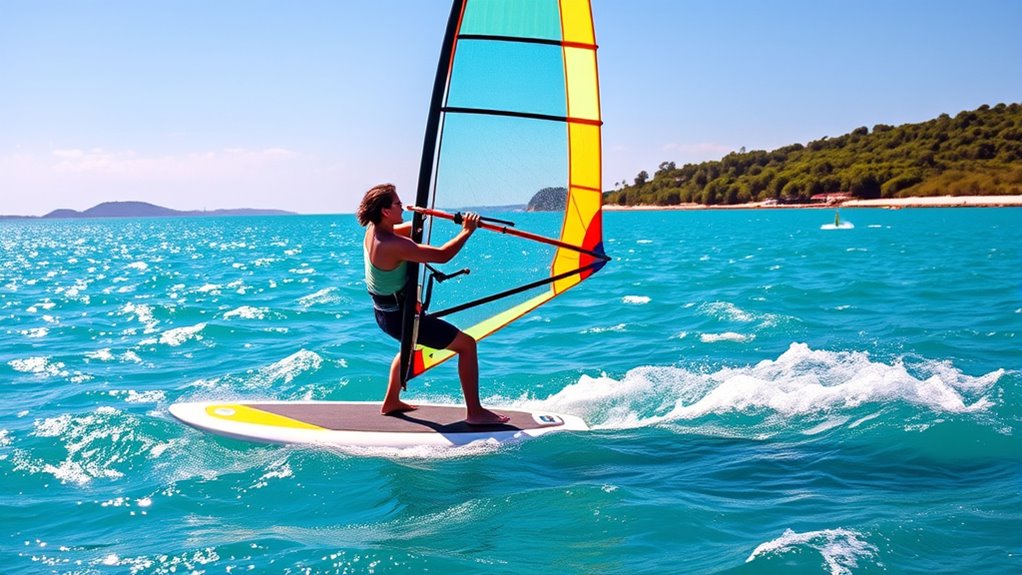
Practicing tacking and jibing is essential for gaining control and maneuverability on your windsurfing board. Focus on practicing progressions smoothly, which helps you become more confident switching directions. As you work through these movements, you’ll develop stance stability, making your shifts more balanced and controlled. Start by approaching each turn slowly to better understand your board’s response. Keep your weight centered and shift it gradually as you turn the sail around, maintaining a steady posture. Repetition is key—each successful transition builds muscle memory and improves your coordination. Over time, your tacking and jibing will become more fluid, allowing you to handle different wind conditions with ease. Consistent practice will boost your confidence and make your windsurfing experience more enjoyable.
Safety Tips for Beginner Windsurfers

Since windsurfing involves variable conditions and equipment, prioritizing safety is essential for beginners. Always wear proper safety gear, like a life jacket and helmet, to protect yourself in case of falls. Familiarize yourself with emergency procedures before heading out, so you stay calm during unexpected situations. Here are key safety tips:
- Check weather conditions and wind forecasts before going out.
- Use appropriate safety gear at all times.
- Stay within designated windsurfing areas to avoid hazards.
- Practice self-rescue techniques for emergencies.
Building Confidence on the Water
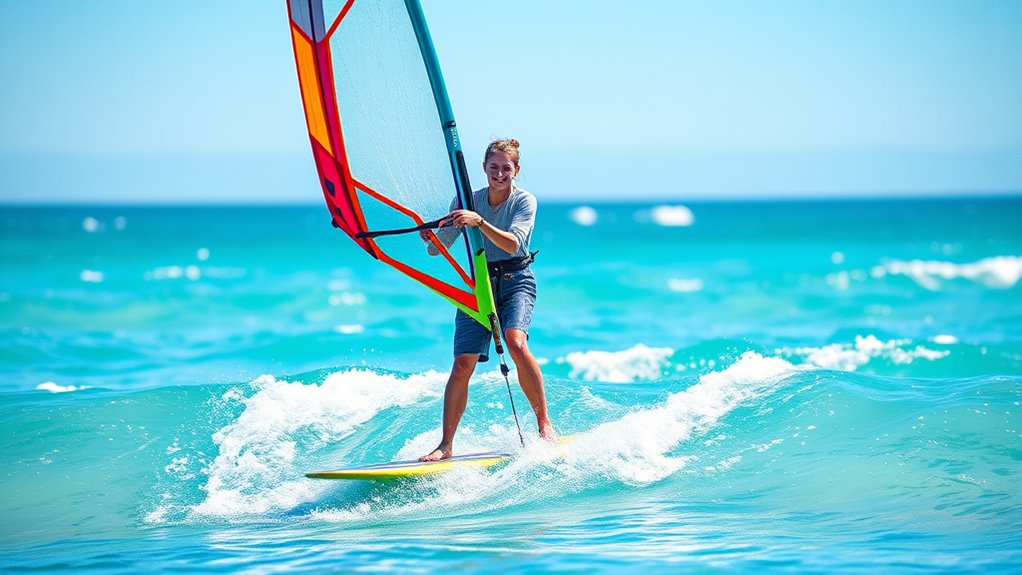
Building confidence on the water comes from gaining experience and trusting your skills. Mental preparation is key—visualize your movements and stay positive before hitting the water. Practice in calm conditions to build a solid foundation, and gradually challenge yourself as you improve. Weather forecasting plays a vital role; check the wind and tide conditions to guarantee safety and reduce anxiety. Knowing what to expect helps you stay calm and focused, making each session more productive. When you understand weather patterns and prepare mentally, you’ll feel more in control, which boosts your confidence. Remember, setbacks are part of learning. With consistent practice, good mental prep, and awareness of weather, you’ll find yourself more comfortable and confident on the water.
Frequently Asked Questions
How Do I Choose the Best Windsurfing Location for Beginners?
You should look for a location with consistent, gentle wind conditions and calm waters. Choose beginner-friendly beaches that have shallow, protected areas perfect for learning. Check local wind conditions before heading out, ensuring the winds aren’t too strong or gusty. A spot with easy access and nearby facilities makes your experience more enjoyable. By selecting a safe, beginner-friendly beach with reliable wind, you’ll build confidence and improve faster.
What Common Mistakes Should I Avoid as a Beginner?
You might find yourself wobbling or losing balance, but avoid common beginner mistakes like neglecting proper stance or skipping equipment maintenance. When you focus on maintaining a proper stance, you stay steadier on the board. Regularly check your gear to guarantee safety and performance. Remember, small adjustments make a big difference. By staying attentive to these details, you’ll build confidence and enjoy your windsurfing journey more fully.
How Can I Prevent Injuries While Learning Windsurfing?
To prevent injuries, always wear proper safety gear like a life jacket, helmet, and wetsuit. Before hitting the water, focus on technique reinforcement—practice basic movements on land and in calm conditions. Stay aware of your limits, avoid crowded areas, and listen to your instructor’s advice. Taking these precautions helps you stay safe, build confidence, and enjoy windsurfing while minimizing the risk of accidents.
What Are the Signs of Overexertion or Fatigue?
When you notice signs of overexertion or fatigue, pay attention to muscle fatigue and dehydration symptoms. You might feel excessive muscle soreness, weakness, or cramping, and notice dry mouth, dizziness, or dark urine. These signs indicate you need to rest, hydrate, and recover. Ignoring them can lead to injury or worse. Listen to your body, take breaks, and stay well-hydrated to keep your windsurfing experience safe and enjoyable.
How Do Weather Changes Affect Windsurfing Safety?
Weather changes can greatly impact your windsurfing safety. When wind speed variations occur, they can make controlling your board more difficult, especially if you’re not prepared. Similarly, wind direction shifts can catch you off guard, leading to loss of balance or falling. Always monitor weather reports closely, stay alert for sudden changes, and be ready to adapt your plans to guarantee a safe and enjoyable experience on the water.
Conclusion
With patience and practice, your progress will propel you forward. Embrace each experience, enhance your expertise, and enjoy the exhilarating evolution of windsurfing. Remember, perseverance paves the path to proficiency, turning challenges into charming chapters of your water adventures. So, stay steadfast, seek skills, and savor the salty success. With consistent commitment, your confidence will climb, making every ride a rewarding, remarkable win on the waves.

